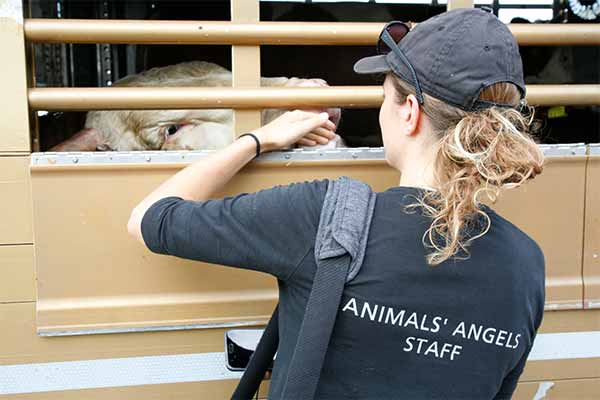Animals' Angels is again inspecting animal transports on the Baltic route towards Poland. After our complaints last summer, we are checking whether anything has changed for the animals on the transports since then. Our attention is on the discarded 'dairy' cows, which are not profitable for milk production and are therefore sold to the slaughterhouse.
True, we do not find cows with milk flowing from their udders because they were not milked in time - that was different last summer. But we are still appalled by the condition of many animals and the impossible conditions on the transports. Not even bedding is granted to most of them on their last journey. They stand on the bare and slippery metal floor in their own excrement. As in the case of Majka and 27 other cows being transported from Latvia to a Polish slaughterhouse.
We accompany them from Lithuania to Poland until after midnight. During a driver's break, we get a closer look at the animals and are shocked: Majka is highly emaciated, she is just skin and bones. Several parts of her pelvic area are without fur and partially sore. Her rear end is very dirty. Unfortunately, the other cows do not look any better. Cow Aiva is also extremely thin - her ribs are protruding and her flanks are severely sunken. Her bulging udder looks inflamed - is she suffering from mastitis? Cow Ingrida's right horn has grown towards her head and is pressing into her eye socket.
We see emaciated, neglected and dirty cows with skin abrasions on the pelvis. Their udders are partly still filled with milk and reddened. What must the conditions be like in the husbandry from which these animals come? It is not acceptable that the animals are exploited and at the end of their short "production life" are as weak and frail as Majka and Aiva. And then they are even transported long distances to the slaughterhouse without being provided with something as simple as bedding. The ceiling height in the truck is also too low for at least two cows.
On site, we try to document as much as possible, which is not easy. The truck's side openings are almost closed due to the low temperatures. In painstaking follow-up work, we gather all the evidence and file a comprehensive complaint with the responsible veterinary authorities. They must finally take action and consistently punish such transports or not approve them in the first place. We also call on them to take a close look at the farms of origin of the animals. At EU level, we are continuing to campaign for a ban on long animal transports in the course of the ongoing revision of the Animal Welfare Transport Regulation - especially of such vulnerable animals as discarded 'dairy' cows.










